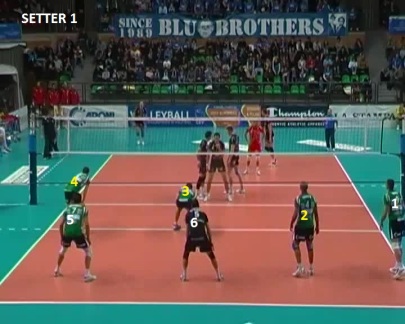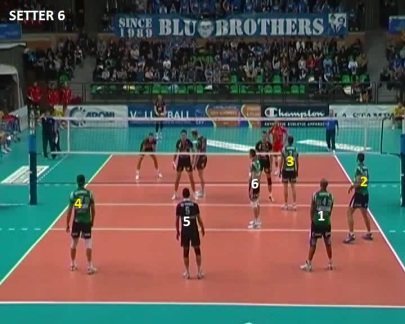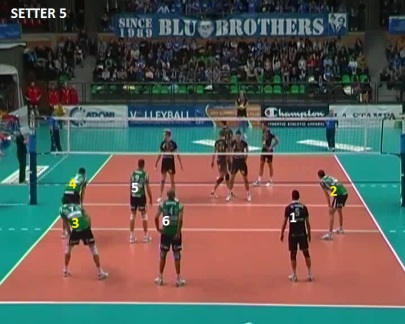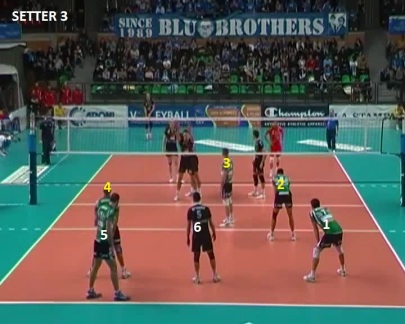Last week’s Champions League Playoff 6 was notable for a couple of reasons. Polish club Kedzierzyn Kozle beat last season’s Final Four performers Izmir to reach the last stage for the first time in nearly ten years. Zenit Kazan celebrated the knocking out of perennial finallists Trento by crushing fellow Russians Dynamo Moscow. And Italian powers Macerata and Cuneo faced off against each other. The Italian match up was the closest, with Cuneo reaching their first ever Final Four in the golden set, but it was also interesting as neither team played with a ‘traditional’ lineup.
Due to personnel problems Cuneo have been using a lineup with one setter, two receivers (who played in the standard manner), one middle (who plays in the standard manner) and two opposites, as seen below.

Grbic is the setter, N’Gapeth and Wijsmanns the receivers, Kohut the middle blocker, Sokolov is nominally the other middle blocker and Antonov is nominally the opposite. Antonov plays as the opposite across the front row and with the setter in position 4. Sokolov, who is their best opposite, plays middle across the front row and as the opposite with the setter in position 3 and 2.
P1 – SETTER IN POSITION 1
Sokolov in position 3 plays as a middle. In the alternative version, a middle is subsituted for Antonov and Sokolov spikes from position 4.


P6 – SETTER IN POSITION 6
Standard, with Sokolov playing as a middle blocker. In the alternative version, where a middle is subsituted for Antonov, Sokolov spikes from position 2.

P5 – SETTER IN POSITION 5
Completely standard. Sokolov takes a break… most of the time (see video below).

P4 – SETTER IN POSITION 4
Sokolov reenters for the serve, and the libero comes in for Antonov. When the two are on the court at the same time (ie during the serve), Sokolov plays in position 1.

P3 – SETTER IN POSITION 3
As P4, with Sokolov as opposite and the libero on for Antonov.

P2 – SETTER IN POSITION 2
Another standard rotation. Antonov playing as opposite and Sokolov in the frontrow as middle blocker.

I don’t think this lineup will become a new paradigm, but it is interesting to see another situation where a team has chosen to play a player ‘out of position’ in order to have the best six players on the court rather than the players who best fit into the individual ‘slots’. Truly creating a system to fit the players.
However, when you do something new sometimes wires get crossed. In this particular case, sometimes you end up with seven players on the court. And they still couldn’t get the ball over the net…
Part 1 on Macerata

I think that the problem is not that top elite coaches specialise – its that lower level coaches specialise, then the players can’t really do anything else.
LikeLike
I think this is a great point. Top level coaches can’t use players in positions they don’t have the skills for. That is up to junior coaches.
LikeLike
Jim McLaughlin about cost-benefit analysis, taking risks and facing criticism. “A lot of those people don’t know … everybody’s got an opinion.” I think his thoughts apply perfectly to Roberto Piazza’s situation. Congrats to Piazza, Alekno and all those coaches who think beyond what habit and tradition state.
LikeLike
Great post and charts! Very interesting seeing Cuneo with 2 opposites and 1 middle. The Argentina teams with Milinkovic played non-tradfitional lineups too. I remember watching the Bergamo v Villa Cortese match at the FIVB setting seminar and seeing how at the end of the 1st set, Lo Bianco gets subbed off for a blocking sub and Bergamo wins about 3-4 rallies in transition without a server. It is something teams have to get good at.
I wonder what players think about playing “out of position”. Would a player rather be on the court playing out of position than sitting on the bench while a less talented player starts?
LikeLike
I’ve coached teams where players have started ‘out of position’ (in this case players as a passer/hitter rather than a middle), and its been made clear that they would absolutely not be starting as a middle, and quit to go and play somewhere else as a middle.
LikeLike
someone quit to play middle instead of passer hitter?
LikeLike
The Milinkovic teams mostly also had Conte, who had a unique skill set, especially in the latter part of his career. Milinkovic was a great player, one of my favourites, but might not have had quite so much success if Conte wasn’t there with him.
LikeLike
Very interesting analysis.
The stats sheet (http://www.cev.lu/Competition-Area/MatchStatistics.aspx?ID=24380) shows imo three interesting things:
1. Sokolov still managed to become top scorer.
2. Ball distribution is more balanced than usually (4 players of the starting lineup with 25 attacks or more).
3. Last but not least, one argument regarding the question which of the two non-traditional lineups is better: Cuneo won.
LikeLike
Good observations. Sokolov also hit the most balls, which is a good achievement considering he only hit outside in two rotations!!
LikeLike
Thanks for this series, Mark. I thought that I left a comment on the first part, but it’s gone. Anyway: Somewhere in the middle of the season my team (4th league) faced a similar situation. We had only one (inexperienced) middle and had to play three outside hitters. To me it looked like a big chance coming up, because as you said virtually every team in the world plays the same system. And I think we came up with something really good. We even had the players for it 😉
But: What seemed to work in practice, didn’t go too well in the games. I had to admit that the players didn’t believe that a system that no other team plays could work.
It turned even worth when we had to play the number 1 team with only six players and one of them with an injured shoulder. Believe it or not, I made him the second middle. The three rotations he was in the front row we dropped him back for defence. Also he had to serve from below (is that the correct terminus for an “Aufschlag von unten”?).
And it worked pretty good, the opponent had so much trouble adopting to our “strange” tactic that they couldn’t take advantage of only two blockers. But since my players didn’t believe that this could work against the number 1 we made so many easy faults that we lost the match in three straight sets. Althoug the last one ended 28:30 😀
LikeLike
Hugh McCutcheon often says that the coach must be a salesman, also to his own team.
Changing the system is always a risk because not only the players must believe but also the fans/management/press. If it is not successful it must be the coach’s fault. And then there is only one possible outcome.
LikeLike
I am not fired – yet 🙂
LikeLike
Hi colleagues, good post and good arguments
commented at this place, I am truly enjoying by these.
LikeLike
Two years after the discussion has ended, I have just read the two parts and decided to jump in. Better late than never 🙂 A really great post, both parts are still extremely interesting. I remember I watched these two games very carefully exactly because of the unconventional coaches’ decisions. We all love those 🙂
1. I was going to mention Lorenzetti’s Piacenza, but there was no way for you guys not to know their system. They reached the 2008 CL final with a universal player like Granvorka.
2. One of my favourite tournaments ever was the WCH 2002. I have access to only 5-6 games from that event (I am not a scout), there are stats sheets for the rest. I agree, Argentina used a very interesting rotation as well, but they had a skillful team as well indeed. Also, I think Croatia used some untraditional system back then, Igor Omrcen was in the team and he has a history of performing both as a middle blocker and an opposite. Unfortunately, I have never found videos of their team…
3. Just a quick note on a comment from the first part. Yes, Alekno’s decision to change his opposite during the OG 2012 final match was ingenious, but let me remind you that Muserskiy had already competed as an opposite for his club Belgorod before that. The role was not entirely new to him, hence the risk was worth it 😉
4. Thanks for the graphics! I have both matches on my hard drive at home, but as I am not a scout myself, I enjoyed this angle more.
LikeLike